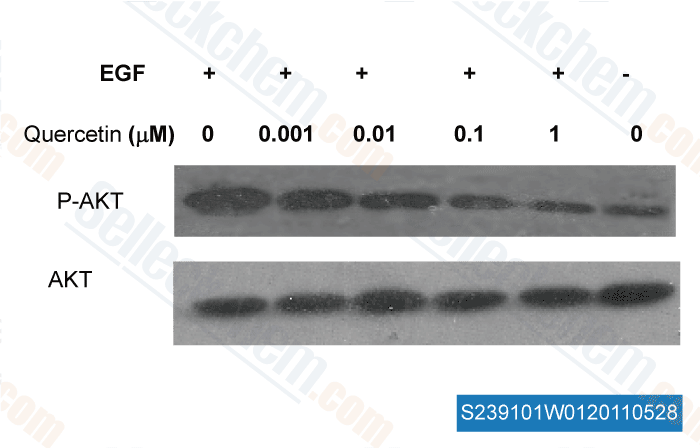|
Toll Free: (877) 796-6397 -- USA and Canada only -- |
Fax: +1-832-582-8590 Orders: +1-832-582-8158 |
Tech Support: +1-832-582-8158 Ext:3 Please provide your Order Number in the email. |
Technical Data
| Formula | C15H10O7 |
||||||
| Molecular Weight | 302.24 | CAS No. | 117-39-5 | ||||
| Solubility (25°C)* | In vitro | DMSO | 61 mg/mL (201.82 mM) | ||||
| Ethanol | 20 mg/mL (66.17 mM) | ||||||
| Water | Insoluble | ||||||
| In vivo (Add solvents to the product individually and in order) |
|
||||||
|
* <1 mg/ml means slightly soluble or insoluble. * Please note that Selleck tests the solubility of all compounds in-house, and the actual solubility may differ slightly from published values. This is normal and is due to slight batch-to-batch variations. * Room temperature shipping (Stability testing shows this product can be shipped without any cooling measures.) |
|||||||
Preparing Stock Solutions
Biological Activity
| Description | Quercetin, a natural flavonoid present in vegetables, fruit and wine, is a stimulator of recombinant SIRT1 and also a PI3K inhibitor with IC50 of 2.4-5.4 μM. Quercetin induces mitophagy, apoptosis and protective autophagy. Phase 4. | |||||||||||
|---|---|---|---|---|---|---|---|---|---|---|---|---|
| Targets |
|
|||||||||||
| In vitro | Quercetin is a type of plant-based chemical, or phytochemical, known as a flavonol and a plant-derived flavonoid found in fruits, vegetables, leaves and grains. It also may be used as an ingredient in supplements, beverages or foods. In several studies, it may have anti-inflammatory and antioxidant properties, and it is being investigated for a wide range of potential health benefits. Quercetin (Sophoretin) is a PI3K inhibitor with IC50 of 2.4 – 5.4 μM. It strongly abrogated PI3K and Src kinases, mildly inhibited Akt1/2, and slightly affected PKC, p38 and ERK1/2. [1] Quercetin inhibits TNF-induced LDH% release, EC-dependent neutrophils adhesion to bovine pulmonary artery endothelial cells (BPAEC), and BPAEC DNA synthesis and proliferation. [2] |
|||||||||||
| In vivo | Combination of Quercetin (75 mg/kg) and 2-Methoxyestradiol enhances inhibition of human prostate cancer LNCaP and PC-3 cells xenograft tumor growth.[3] LD50: >3000mg/kg (i.g.) [4] |
Protocol (from reference)
| Cell Assay: |
|
|---|
References
Customer Product Validation

-
Data independently produced by Dr. Zhang of Tianjin Medical University, 2011
Selleck's Quercetin has been cited by 48 publications
| Discovery of the therapeutic potential of naltriben against glutamate-induced neurotoxicity [ Neurochem Int, 2025, 183:105928] | PubMed: 39756586 |
| Sensing steroid hormone 17α-hydroxypregnenolone by GPR56 enables protection from ferroptosis-induced liver injury [ Cell Metab, 2024, S1550-4131(24)00371-1] | PubMed: 39389061 |
| Increased PTCHD4 expression via m6A modification of PTCHD4 mRNA promotes senescent cell survival [ Nucleic Acids Res, 2024, gkae322] | PubMed: 38721764 |
| Downregulated SPESP1-driven fibroblast senescence decreases wound healing in aged mice [ Clin Transl Med, 2024, 14(5):e1660] | PubMed: 38764260 |
| FGF receptors mediate cellular senescence in the cystic fibrosis airway epithelium [ JCI Insight, 2024, 9(15)e174888] | PubMed: 38916962 |
| Investigating the potential mechanism and therapeutic effects of SLXG for cholesterol gallstone treatment [ Phytomedicine, 2024, 132:155886] | PubMed: 39059092 |
| Senolytic therapy preserves blood-brain barrier integrity and promotes microglia homeostasis in a tauopathy model [ Neurobiol Dis, 2024, 202:106711] | PubMed: 39437971 |
| Quercetin-induced pyroptosis in colon cancer through NEK7-mediated NLRP3 inflammasome-GSDMD signaling pathway activation [ Am J Cancer Res, 2024, 14(3):934-958] | PubMed: 38590424 |
| The p21+ perinecrotic hepatocytes produce the chemokine CXCL14 after a severe acetaminophen overdose promoting hepatocyte injury and delaying regeneration [ Toxicology, 2024, 504:153804] | PubMed: 38614205 |
| Single-cell morphology encodes functional subtypes of senescence in aging human dermal fibroblasts [ bioRxiv, 2024, 2024.05.10.593637] | PubMed: 38798365 |
RETURN POLICY
Selleck Chemical’s Unconditional Return Policy ensures a smooth online shopping experience for our customers. If you are in any way unsatisfied with your purchase, you may return any item(s) within 7 days of receiving it. In the event of product quality issues, either protocol related or product related problems, you may return any item(s) within 365 days from the original purchase date. Please follow the instructions below when returning products.
SHIPPING AND STORAGE
Selleck products are transported at room temperature. If you receive the product at room temperature, please rest assured, the Selleck Quality Inspection Department has conducted experiments to verify that the normal temperature placement of one month will not affect the biological activity of powder products. After collecting, please store the product according to the requirements described in the datasheet. Most Selleck products are stable under the recommended conditions.
NOT FOR HUMAN, VETERINARY DIAGNOSTIC OR THERAPEUTIC USE.
